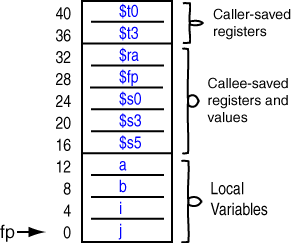a = a + 1;
Answer:
lw $t0,12($fp) # get a addiu $t0,$t0,1 # a + 1 sw $t0,12($fp) # a =
a = a + 1;
lw $t0,12($fp) # get a addiu $t0,$t0,1 # a + 1 sw $t0,12($fp) # a =

A real-world linkage convention allows many types of objects to go into a stack frame. The following rules assume that the stack only stores 32-bit values. There are other features of real-world linkage that the following does not have.
Calling a Subroutine (done by the caller):
- Push any registers
$t0-$t9that contain values that must be saved. Push the registers in numerical order.- Put argument values into
$a0-$a3.- Call the subroutine using
jal.
Subroutine Prolog (done by the subroutine):
- Push
$ra(always).- Push the caller's frame pointer
$fp.- Push any of the registers
$s0-$s7that the subroutine might alter.- Initialize the frame pointer:
. The "space for variables" is four times the number of local variables. (Remember that subtracting from $fp = $sp - space_for_variables$spgrows the stack, and that our variables are always four bytes wide).- Initialize the stack pointer:
$sp = $fp.
- At this point the stack looks like the above picture.
- The subroutine may alter any
T,A, orVregister, or anySregister that it saved in the prolog.- The subroutine refers to local variables as
disp($fp).- The subroutine may push and pop values on the stack using
$sp.- If the subroutine calls another subroutine, then it does so by following these rules.
Subroutine Epilog (done at the end of the subroutine):
- Put return values in
$v0-$v1$sp = $fp + space_for_variables.- Pop into
$s0-$s7any values for them that were previously saved in the frame.- Pop the caller's frame pointer into
$fp.- Pop
$ra(always).- Return to the caller using
jr $ra.
Regaining Control from a Subroutine (done by the caller):
- Pop any registers
$t0-$t9that the caller previously pushed.
When the caller gets control back, are its frame pointer and stack pointer the same as when it called the subroutine?